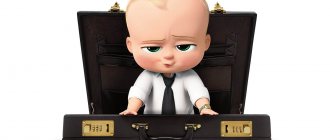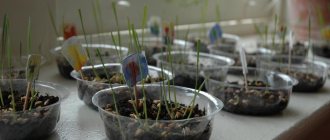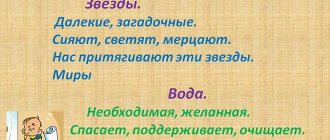The magical role of fairy tales
A children's fairy tale is a necessary element in raising a child; it tells him in an accessible language about life, teaches him, illuminates the problems of good and evil, and shows the way out of difficult situations.
A fairy tale is the language of children; for them it is more informative than the compressed, insipid adult speech. Therefore, if we, adults, want to help, explain, support, reveal something to our child, then we need to re-learn the forgotten children's language - fairy tales.
By telling and reading fairy tales, we raise a child, develop his inner world, give him knowledge about the laws of life and ways to demonstrate creative ingenuity.
Children who have been read fairy tales from early childhood quickly begin to speak not just in a set of words, but in good literary language.
A fairy tale forms the foundations of behavior and communication in a child for life, teaches perseverance, patience, and the ability to set goals and go towards them. Listening to fairy tales, children accumulate in the subconscious mechanisms for solving life situations, which are activated when necessary.
The fairy tale develops the creativity, fantasy, imagination and empathy of the little man.
There is always a lesson in a fairy tale, but the lesson is very gentle, kind, rather, it is friendly advice.
So why not use a fairy tale to correct children's speech?
One of the most important principles in working with children, especially in speech therapy classes, is the principle of repetition, which is explained by a reduced ability to automate skills. But the child quickly gets bored with the same exercises. In order to interest children, all exercises can be combined into short fairy tales. Teachers and parents can come up with these fairy tales, or you can invite the child to fantasize. And then the usual activity will sparkle with new colors and emotions, and accordingly the child will be able to quickly master the necessary knowledge and skills.
The proposed fairy tales were invented to practice sets of exercises that develop the correct articulatory structure of various sounds. You can tell a story and do exercises at the same time.
Fairy tale “How a mouse and a kitten became friends.”
One morning the kitten Timka woke up very early, scratched himself behind the ear with his paw and decided to wash his face and comb his hair (exercise “Comb”). The kitten smiled, stretched (exercise “Frogs are smiling”, “Fence”) and suddenly became wary (exercise “Donut”). What is this noise? I listened, and the clock was ticking (exercise “Clock”). No, it’s not just a watch, something else is making noise.
And then Timka noticed a little mouse, which quickly ran towards the pantry with its paws. The kitten was very surprised, then he was delighted and began to quietly sneak behind the mouse. He seized the moment, jumped and grabbed the mouse in his front paws. The mouse was so scared that he closed his eyes and stopped breathing completely.
"Mrrr meow!" - Timka said and licked his lips (exercise “Delicious jam”). The mouse opened one eye and saw sharp cat teeth right in front of him. He wanted to squeak, but from fear he could not utter a sound and only weakly moved his tongue (exercise “Calyx”).
- What, you can’t talk? — the kitten was surprised and moved the mouse’s paw.
The mouse opened his second eye, smiled and was even able to click his tongue (exercise “Horse”).
- What's wrong with you? Let's play! - Timka said and licked the mouse with his tongue.
- Uff! — the mouse was finally able to exhale (exercise “Proboscis”). - So you want to play?
- Well, yes! And what did you think? - Timka was surprised. - Now everyone is still sleeping, and I’m bored. Let's be friends!
- Let's! – the mouse agreed.
And now every morning they play together (exercise “Swing”), and the mouse Timka is no longer the least bit afraid!
Fairy tale "Resourceful little bear."
Once upon a time there lived a bear cub. Every morning, as soon as he woke up, he brushed his teeth (exercise “Brushing our teeth”) and went for a walk. After all, there are so many interesting things around!
One day he walked like this on a sunny summer day until he felt that he was very hungry. The little bear stroked his tummy with his paw and wondered where he could get tasty, sweet strawberries (exercise “Let’s stroke the tongue and lips with our teeth”). The little bear looked around and decided to look for a clearing with berries. First he had to go down the slide (exercise “Slide”). Mishka stopped under a tree to rest a little and then he heard some kind of bird singing above his head (exercise “The little engine whistles”).
The little bear threw back his head and politely asked: “Dear bird, you are sitting so high, maybe you can see a clearing with strawberries? Tell me which way I should go!” But no one answered him. Bear scratched his head with his paw and thought that the bird had not heard him and that he needed to climb higher and shout louder. He jumped, grabbed the trunk with his paws and began to slowly, pushing with all his might, climb up (exercise “Strongman’s tongue”). Then the bear cub pulled himself up a little more, hung on a branch and began to swing (exercise “Swing”).
“Hey, is there anyone there?!” the bear cub shouted, but again no one answered him. Then he rose even higher, even stretched out his tongue from the effort (exercise “Spatula”), and suddenly from above he saw a clearing in which a lot of strawberries grew.
- Hooray! It's good that I came up with the idea of climbing a tree! - the bear cub shouted and rolled out of the tree as quickly as he could (exercise “Reel”).
He caught his breath under a tree and quickly ran to the clearing to finally refresh himself.
Fairy tale "Ill-mannered mouse."
There lived in the forest one ill-mannered mouse. He didn’t say “good morning” or “good night” to anyone. All the animals in the forest were angry with him - they did not want to be friends with him. The mouse felt sad. He went to his mother and asked: “How can I make peace with all the animals in the forest? " Mom tells him that he needs to be polite to everyone. The mouse decided to improve, brushed his teeth (exercise “Brush your teeth”), combed his hair (exercise “Comb”).
He sees a bunny swinging on a swing (exercise “Swing”). He came up and loudly greeted “Good morning!”
The bunny smiled and treated the mouse to a carrot. The mouse was happy and moved on. A snake crawls towards you (exercise “Fast snake”), holds a weight in its tongue so that it is strong (exercise “Tongue-strongman”).
And the mouse greeted her. The snake was surprised and dropped the weight. The mouse really liked being polite. He ran further to say hello to someone else. He sees a crow sitting on a tree and holding a bagel in his mouth (exercise “Bagel”).
The mouse shouted loudly to her, “Good morning!” The crow croaked in response and flew off to tell everyone how polite the mouse had become.
And the mouse kept running through the forest, saying hello to everyone, and was so tired that he tripped and rolled down the hill (exercise “Slide”).
Almost fell into the water. Well, the little fence that the little frogs built held him back (exercise “Fence”).
He rested, looked around, and saw frogs jumping, inviting him to play with them.
But the mouse has no time to play - he hasn’t wished everyone good morning yet. He runs through the forest and sees: a bat has woken up in a tree. "Good morning!" - the mouse shouts to her. “It’s already evening,” the bat answers, “good evening, little mouse!” And the mouse whistled cheerfully, like a train (exercise “The train whistles”). And he ran home so that his mother would not worry that he had been gone for so long.
It is useful for children to repeat fairy tales with their parents and teachers. Such consolidation of material can be an additional task for the development of vocabulary, grammar, and coherent speech.
Good luck in your studies, joy in communication!
Application.
Psychological and speech therapy fairy tale for children 5-7 years old
Psychological and speech therapy fairy tale for children of senior preschool age, with elements of fairy tale therapy. “It’s bad to be a brawler.”
Objectives: 1. Psychoprophylaxis of aggressive behavior in children of senior preschool age; 2. Development of coherent speech. Objectives: 1. Psychoprophylaxis of aggression in children of senior preschool age through the hero of a fairy tale, through a puppet show; 2. Relieving psycho-emotional stress and emancipation of pupils; 3. Development of children's creative abilities; 4. Teaching children to recognize various emotional states using the example of fairy tale characters; 5. Teaching children to expressively retell the text of a fairy tale by role; 6. Activation and expansion of children’s vocabulary on the topic “Insects”; 7. Teaching children the correct pronunciation of whistling and hissing sounds in coherent speech, differentiation of whistling and hissing sounds. 8. Fostering children's interest in nature; 9. Teaching the norms of correct behavior and communication. Job Description: Psychological and speech therapy work with children is divided into three stages. I (preparatory) stage: Adults (speech therapist and psychologist) show a puppet show for children. The psychological goal of this stage is the psychoprevention of aggressive behavior in children through watching the performance and discussing the performance after its completion. Children learn to identify a bad and a good hero, the main idea of a play, independently formulate the moral of a fairy tale, and get an emotional charge. The speech therapy goal of this stage is for children to listen to a sample of correct speech (taking into account voice modulations, pauses) and to prevent agrammatisms when constructing sentences during a conversation. Stage II At the second stage, children become more closely acquainted with the heroes of the fairy tale, consider them, fill the heroes with their character and life values. At this stage, children freely manipulate dolls and, with the support of an adult, independently perform the performance using dolls. Children are invited to play different roles and play with different dolls. After such mini-performances, a discussion of everything that happened is mandatory. Children take turns talking about their emotional state, whether they liked playing with this or that doll or not, talk about how their mood changed as the fairy tale played out, whether they wanted to be this hero or not. Stage III The third stage is the final one. Here the children are already moving away from the hero doll and taking on the role for themselves. At this stage, it is also important that children play the role of a good and a bad hero, feel the difference between them, experience all the hero’s experiences through themselves, after which the children are assigned to a specific role and stage a theatrical production for other children (younger or older than themselves, or for their peers). Music is playing. Presenter (Dasha): “In the city of Zhuzhalsk the beetle Seryozhka lived (the beetle comes out).” Beetle (Sasha): “Here I am! Well, weren’t you waiting?” Host: There was a prankish bug, he loved to fight. (The beetle agrees) He offended his neighbors and did dirty tricks. The beetle Seryozhka was literally punished. The beetle stands aside and a bee flies out to the music. Presenter: One morning Tanya the bee brought honey for her friends.
Bee (Sonya): I collected honey for my friends, Come and visit me for tea soon. All the insects fly out to the sound of buzzing and drink tea. Then Seryozhka flies out. Presenter : But the bug Seryozhka, a harmful soul, knocked over the vase of honey slowly. (Seryozhka laughs: Ha-ha-ha!). And he still laughs, his mustache trembles, But the rest, complaining, buzz. (Everyone scolds Seryozhka and buzzes, then everyone scatters). Presenter: Now time passes and again there is a scandal, Our bug Seryozhka has become even worse. (A butterfly flies, Seryozhka pushes it and it falls). He offended the butterfly and bit the bee. (Earring bites a bee and goes to beat an ant). I just beat Lenka the ant. And Lyonka exclaimed: Ant : I can’t do it anymore! I'd better run away from you guys! Why are you silent, the beetle has become insolent, Seryozhka is responsible for so many harmful deeds! Presenter : Then the butterfly said: Butterfly : But Lenka is right! It’s hard for us to bear this bad temper! Alenka the dragonfly suffered the worst of all; she ended up in the hospital with a burnt wing. Dragonfly : The wing was, of course, quickly healed! The spiders were doctors in that hospital. The spiders (David and Alim) come out and inspect the dragonfly: Breathe - don’t breathe, We are always ready to help everyone. We are on duty day and night. Well, we give the beetle some advice: Don’t play with fire, beetle!
Presenter : And then they decided to punish Seryozhka, but for now not to reveal that secret to everyone. (Everyone flies away to the music). Well, the beetle Seryozhka lived as always! (The Beetle appears). Beetle : Being weak today is nonsense! Only the strongest will succeed in everything. I will live as before, offending everyone! (The beetle laughs, waves its fists, threatens). Presenter : But he soon found out how wrong he was! On his own birthday, he was left alone. And although I distributed invitations to everyone, no one began to congratulate Seryozha! (Seryozhka walks and cries). Beetle : I myself deserved such a share, I was bad, pugnacious and disgusting. I won’t lie, make noise, or swear anymore! I will even forget how to bite and fight. I’ll become kinder, I’ll ask for forgiveness, And maybe everyone will come for my birthday! (Joyful music sounds and all the insects flock with gifts, the beetle asks for forgiveness) Host: And they came, of course, and forgave the beetle! And they gave him magic wings! And whoever can catch the sound of the wings will live long on earth happy! (funny music)
We recommend watching:
A fairy tale about the culture of communication for children 5-7 years old A fairy tale about a musical instrument for children 5-7 years old A fairy tale about a Hedgehog for children 5-10 years old A fairy tale for children 4-7 years old about the seasons
Similar articles:
Kipling "The Cat Walked Alone"
Description of articulation exercises used in fairy tales.
Exercises to relax the muscles of the articulation organs and to form lip movements.
Stroke, then lightly bite the lower lip with your teeth.
“Comb”: “comb” the upper and lower lips with our teeth in turn.
“Frogs are smiling”: learn to smile with an open smile.
“Fence”: learn to involuntarily hold a smile, slightly opening your teeth.
“Baby elephant trunk”: stretch your lips forward and close them.
“Bagel”: smoothly round your lips and do not close them while counting to 5.
“Watch”: open your mouth, stick out your narrow tongue; pull it alternately to the right and then to the left.
Exercises for correctly pronouncing whistling sounds.
“Spatula”: you need to learn to relax the muscles of the tongue, keeping it wide.
Smile, open your mouth slightly, put your wide tongue on your lower lip, hold it in this position, counting to 5.
Place the spatula in your mouth. Then lower the scapula behind the lower teeth, trying to keep the tongue lying still, not trembling or moving.
“Brushing my teeth”: smile, open your mouth slightly, brush your lower teeth with the tip of your tongue, moving from side to side.
“The little train whistles”: bring a clean bottle to your mouth, stick out the tip of the tongue slightly so that it touches the neck, exhale air smoothly into the bottle.
“Tongue-strongman”: smile slightly, open your mouth slightly, lower the wide tip of the tongue to the lower front teeth; rest your tongue on your teeth.
“Swing”: smile, open your mouth as with the sound “A”; lower the wide tip of the tongue behind the lower teeth (from the inside) and hold it for the count of “ones”; lift your wide tongue by your upper teeth and hold it for the count of “two”; repeat several times, making sure that only the tongue is working, and not the lower jaw.
“Slide”: open your mouth wide, lower your wide tongue behind your lower teeth, rest your tongue against them; Press the side edges firmly against the upper molars.
Exercises for the correct pronunciation of hissing sounds, sounds L, L, R, R.
Learn to stretch your lips with a tube and hold them in that position. (exercise “Baby Elephant’s Trunk”, “Tube”).
“Cup”: open your mouth wide, place the tongue-scapula on the lower lip, lift the edges of the tongue and you will get a bowl.
“Delicious jam”: use the wide tip of the tongue to “lick the jam” from the upper lip, moving the tongue from top to bottom.
“Fast snake”: with a tense tongue movement from the mouth, then back into the mouth; moving the tongue from side to side; moving the tongue left and right along the upper alveoli; hide your tongue in your mouth.
“Horse”: smile, open your mouth slightly, click the tip of your tongue slowly; try to keep the lower jaw and lips from moving, and only the tongue working.





